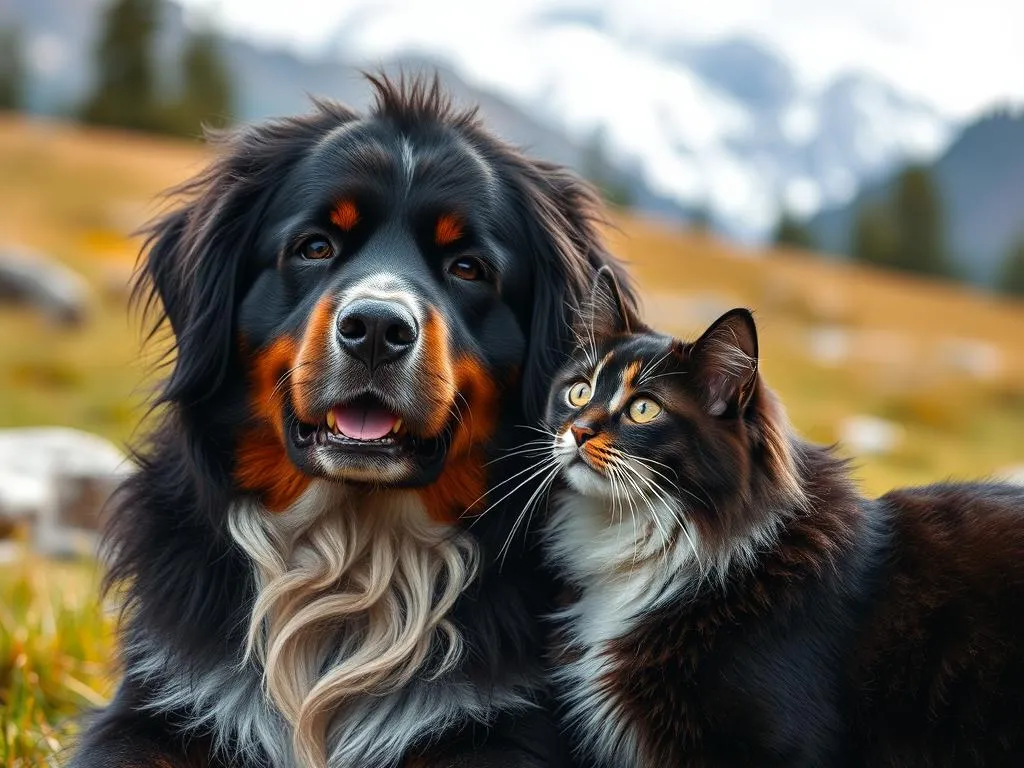
Bernese Mountain Dogs (BMD) are known for their gentle nature, striking appearance, and affectionate disposition. As a breed, they possess a combination of strength and grace, making them both excellent family pets and reliable working dogs. However, if you’re a cat owner considering bringing a BMD into your home, you may find yourself wondering: will Bernese Mountain Dog get along with my cat?
Understanding the dynamics between dogs and cats is crucial for ensuring a harmonious household. While the stereotype of cats and dogs as natural enemies persists, many pets of different species can live together peacefully. This article delves into the compatibility of Bernese Mountain Dogs and cats, exploring the factors that influence their relationships, how to introduce them properly, and what to expect during their interactions.
Understanding the Bernese Mountain Dog
Breed Characteristics
Bernese Mountain Dogs are large, sturdy dogs, often weighing between 70 and 115 pounds. Their distinctive tricolor coat, featuring black, white, and rust coloring, adds to their visual appeal. Known for their calm demeanor, BMDs are intelligent and relatively easy to train, making them suitable companions for families and individuals alike. However, they do have moderate energy levels and enjoy regular exercise to keep them happy and healthy.
Social Nature
BMDs are inherently social animals. They thrive on companionship and often enjoy the company of other pets, including cats. Their herding instincts can sometimes influence their interactions; while they may be inclined to chase smaller animals, this behavior can be managed with proper training and supervision. Understanding how BMDs typically behave around other pets can help you predict how your dog might interact with your feline friend.
Understanding Cats’ Behavior
Cat Personality Types
Cats display a wide range of personalities, from shy and reserved to outgoing and social. While some cats may quickly adapt to a new dog in the household, others can be more territorial and resistant to change. Recognizing your cat’s unique temperament is essential when considering the introduction of a Bernese Mountain Dog.
Territorial Nature
Cats are often highly territorial, and their home environment is crucial to their sense of security. This territorial instinct can cause conflicts when introducing a new dog. If your cat perceives the BMD as a threat to its territory, it may respond with hissing, swatting, or even aggression. Understanding these instincts can help you manage their interactions and foster a peaceful coexistence.
Factors Influencing Compatibility
Age of the Animals
The age of both the BMD and the cat plays a significant role in their potential compatibility. Puppies are generally more adaptable and eager to socialize, making it easier for them to form bonds with cats. Conversely, adult dogs may have established behaviors that could affect their interactions. Similarly, kittens tend to be more curious and open to new experiences, while older cats may be set in their ways.
Socialization and Training
Early socialization for dogs is crucial. A Bernese Mountain Dog that has been properly socialized with cats from a young age is more likely to get along with them. Training techniques, such as positive reinforcement and gradual introductions, can significantly influence how well your BMD and cat adjust to each other.
Individual Personalities
Just like humans, individual pets have unique personalities that can greatly influence their compatibility. A friendly, easy-going BMD may get along perfectly with a laid-back cat, while a high-energy dog might overwhelm a more timid feline. Sharing anecdotes of successful and unsuccessful pairings can provide insight into the variability of these relationships.
Introducing a Bernese Mountain Dog to a Cat
Preparation
Before introducing your BMD to your cat, it’s essential to create a safe environment for both animals. Designate specific areas for each pet to retreat to if they feel threatened or overwhelmed. Ensure that your cat has high perches or hiding spots to escape to, as cats often feel safer when they can observe from above.
The Introduction Process
Introducing a BMD to a cat should be a gradual process. Start by allowing them to smell each other’s bedding or toys to get accustomed to each other’s scent. When it’s time for a face-to-face meeting, keep the dog on a leash and allow the cat to approach at its own pace. Look for signs of comfort, such as relaxed body language from both pets. If either animal shows signs of distress, separate them and try again later.
Post-Introduction Management
Once the initial introduction has taken place, it’s important to monitor their interactions closely. Look for signs of aggression or fear and be prepared to intervene if necessary. Reinforce positive behaviors with treats and praise for both pets when they coexist peacefully. Gradually increase the time they spend together, but always prioritize their comfort and safety.
Potential Challenges
Aggression and Fear Responses
Aggression and fear responses can arise during the introduction phase or even after the pets have been living together for some time. Common causes of these reactions include territorial disputes, fear of unfamiliar situations, or past negative experiences with other animals. Understanding the triggers for aggression can help you address the issues effectively.
Stress Management
Both dogs and cats can exhibit signs of stress in the presence of each other. Common indicators of stress in cats include hiding, excessive grooming, or changes in eating habits. For dogs, signs may include barking, pacing, or destructive behavior. Recognizing these signs early on can help you implement strategies to reduce stress, such as providing separate spaces or engaging in calming activities.
Success Stories: Bernese Mountain Dogs and Cats Coexisting
Real-Life Examples
Many pet owners have successfully integrated Bernese Mountain Dogs and cats into their homes. One owner shared a heartwarming story of their BMD, Bella, who quickly became best friends with their adopted cat, Whiskers. With patience and proper introductions, Bella learned to respect Whiskers’ space, while Whiskers grew comfortable with Bella’s presence. Such stories are not uncommon, as many BMDs exhibit a nurturing disposition that can complement a cat’s personality.
Lessons Learned
Key takeaways from successful introductions often include the importance of patience and understanding. Every pet is unique, and what works for one may not work for another. Observing their body language, respecting their boundaries, and being prepared for setbacks can contribute to a harmonious relationship.
Conclusion
In conclusion, the question of will Bernese Mountain Dog get along with my cat depends on various factors, including the individual personalities of both animals, their ages, and how well they are socialized. With proper preparation, gradual introductions, and ongoing management, many households have successfully blended the two species. While challenges may arise, the potential for a loving and peaceful coexistence is certainly attainable. Remember to be patient and observant as your pets adjust to each other, and you may find that a Bernese Mountain Dog and a cat can become the best of friends.
FAQs
Common Questions
-
Can Bernese Mountain Dogs live with cats?
Yes, many Bernese Mountain Dogs can live harmoniously with cats, especially if they are introduced properly and socialized from a young age. -
What should I do if my dog chases my cat?
If your dog chases your cat, it’s essential to intervene immediately. Use a firm command to stop the behavior, and ensure the cat has a safe space to escape. Gradually reintroduce them using controlled methods. -
How long does it take for a dog and cat to get along?
The time it takes for a dog and cat to get along varies greatly. Some may bond within a few days, while others may take weeks or even months. Patience and consistent management are key.
Tips and Resources
Understanding pet behavior can be complex, but numerous resources are available to help you navigate the dynamics of introducing a Bernese Mountain Dog to your cat. Observing their interactions, seeking advice from professionals, and continuing to educate yourself on pet behavior can significantly enhance your experience.









